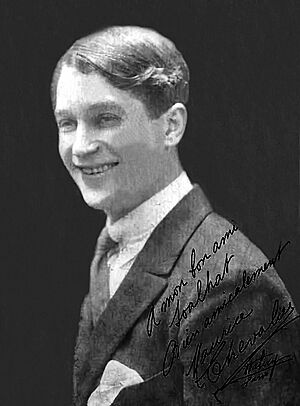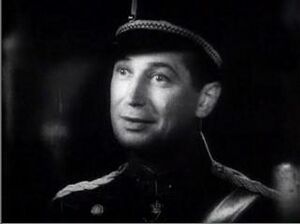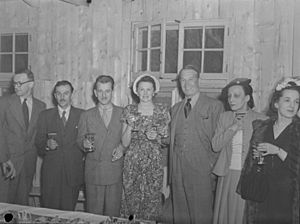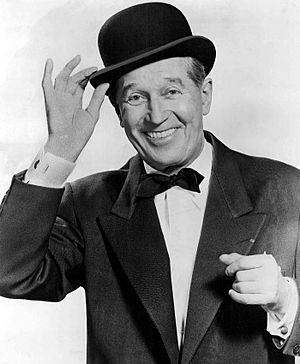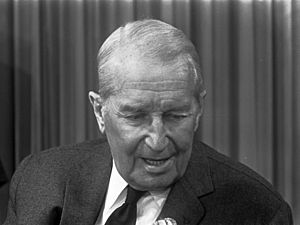Maurice Chevalier facts for kids
Quick facts for kids
Maurice Chevalier
|
|
|---|---|
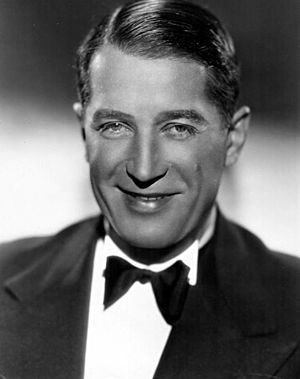
Chevalier, early 1930s
|
|
| Born |
Maurice Auguste Chevalier
12 September 1888 |
| Died | 1 January 1972 (aged 83) Paris, France
|
| Occupation |
|
| Years active | 1900–1970 |
| Spouse(s) |
|
| Musical career | |
| Genres |
|
| Instruments |
|
| Labels |
|
Maurice Auguste Chevalier (born September 12, 1888 – died January 1, 1972) was a famous French singer, actor, and entertainer. He was known for his cheerful personality and his unique style. He often wore a boater hat and a tuxedo.
Maurice Chevalier became famous for his songs like "Livin' In The Sunlight" and "Thank Heaven for Little Girls". He also starred in many movies, including The Love Parade and Gigi.
He was born in Paris, France. Maurice started performing as a singer and dancer when he was very young. In 1909, he became partners with Fréhel, a big star in France. She helped him get his first major role in a show in Marseille. Critics loved his performance.
In 1917, he discovered jazz music. He then went to London and found more success at the Palace Theatre. After that, he toured the United States. There, he met American composers like George Gershwin. He even brought a musical show called Dédé to Broadway in 1922.
When movies started having sound (called talkies), Maurice went to Hollywood in 1928. He starred in his first American film, Innocents of Paris. In 1930, he was nominated for an Academy Award for Best Actor. This was for his roles in The Love Parade and The Big Pond. These films gave him his first big American hit songs.
Later, in 1957, he appeared in Love in the Afternoon. This was his first Hollywood film in over 20 years. In 1958, he starred in Gigi, which was a huge success. In the early 1960s, he made several more films. His final contribution to movies was singing the title song for the Disney film The Aristocats in 1970. Maurice Chevalier passed away in Paris on January 1, 1972.
Contents
Growing Up in Paris
Maurice Chevalier was born on September 12, 1888, in Paris. His father, Victor Charles Chevalier, was a house painter. His mother, Joséphine, was a lace-maker from Belgium. Maurice had two older brothers, Charles and Paul.
When Maurice was eight years old, his father left the family. His mother, Joséphine, had to work very long hours to support her children. She even had to go to the hospital because she was working too hard. Maurice and his brother Paul became very close to their mother. They called her "La Louque." Maurice later named his home after this nickname.
Maurice left school at age ten, hoping to become an acrobat. But he got hurt and had to stop. He tried many different jobs, like a carpenter's helper and an electrician. He even painted dolls! Eventually, he worked at a mattress factory. He became very interested in performing. One day, while daydreaming, his finger got caught in a machine, and he had to stop working.
Starting His Career
While he was recovering in 1900, Maurice offered to sing at a nearby cafe. The owner wasn't sure, but Maurice sang his first song there. People laughed because he sang it too high! Maurice felt discouraged, but his mother and brother Paul told him to keep practicing.
He kept singing for free at the cafe. One day, someone from the theater saw him. They suggested he try out for a local musical. Maurice got the part! He started to become known as a mimic and a singer. His show in Marseille was so popular that when he returned to Paris, a large crowd was waiting for him.
In 1909, he started a relationship with Fréhel, who was the biggest female star in France at the time. After they broke up in 1911, he began a relationship with Mistinguett. He was her younger dance partner at the famous Folies Bergère theater.
World War I Experiences
When World War I began, Maurice Chevalier was serving in the army. He was on the front lines and was wounded by shrapnel (small metal pieces from an explosion). He was taken as a prisoner of war in Germany for two years. While he was a prisoner, he learned English.
In 1916, he was released from prison. This happened because Mistinguett's admirer, King Alfonso XIII of Spain, secretly helped him. King Alfonso was related to both the British and German royal families.
In 1917, Maurice became a star at le Casino de Paris. He performed for British and American soldiers. He discovered jazz and ragtime music. Because he had learned English in prison, he had an advantage over other French artists. He went to London and found new success at the Palace Theatre, even though he still sang in French.
From Paris to Hollywood Stardom
After the war, Maurice went back to Paris. He created several popular songs, including "Valentine" (1924). He also appeared in a few movies. He made a big impression in the musical show Dédé. He met American composers George Gershwin and Irving Berlin. He brought Dédé to Broadway in 1922. That same year, he met Yvonne Vallée, a young dancer. They got married in 1927.
When movies started having sound, Maurice made his Hollywood debut in 1928. He signed a contract with Paramount Pictures. His first American role was in Innocents of Paris. In 1930, he was nominated for an Academy Award for Best Actor. This was for his roles in The Love Parade (1929) and The Big Pond (1930). The Big Pond gave him his first big American hit songs. These included "Livin' in the Sunlight, Lovin' in the Moonlight". He worked with famous film director Ernst Lubitsch.

Maurice Chevalier was so famous that his passport was even shown in the Marx Brothers film Monkey Business (1931). In 1931, he starred in a musical called The Smiling Lieutenant. It was a successful film, even though musicals were not very popular at the time.
In 1932, he starred with Jeanette MacDonald in the film One Hour With You. This movie was a big success and helped make musicals popular again. Because of its popularity, Paramount made another musical with Maurice Chevalier and Jeanette MacDonald called Love Me Tonight (1932). This movie is about a tailor who falls in love with a princess. It's considered one of the greatest film musicals ever made.
In 1934, he starred in The Merry Widow. This was one of his most famous films. He then signed with MGM for The Man from the Folies Bergère. After some disagreements, he returned to France in 1935 to continue his music-hall career.
Even when he was one of the highest-paid stars in Hollywood, Maurice was known for being careful with his money. He later said this was because he grew up in poverty. He felt that "poverty is a disease that can never be cured." When he performed in English, he always used a strong French accent. However, his normal spoken English was actually quite good.
In 1937, Maurice married the dancer Nita Raya. He had several successful shows in Paris. His songs like "Prosper" (1935) and "Ma Pomme" (1936) remained very popular.
World War II and Later Years
Maurice Chevalier continued to perform during World War II. He moved to the south of France with his wife and her parents after German troops invaded in 1940. During this time, patriotic songs became popular. He held charity events to raise money for efforts against the invasion.
Maurice refused to perform for the French government that was working with Germany. He pretended to be sick. But eventually, he agreed to a deal to protect his family. He performed for prisoners of war at the same camp where he had been held in World War I. This performance helped release ten French prisoners.
In 1944, when Allied forces freed France, Maurice was accused of working with the Germans. However, a French court found him innocent. Even so, the English-speaking press was still unfriendly towards him. He was not allowed to enter the U.S. for several years.

In France, he remained popular. In 1946, he separated from Nita Raya. At 58 years old, he started writing his life story. He also began collecting and painting art. He acted in the film Man About Town (1946). He toured the United States and other parts of the world. He returned to France in 1948.
In 1951, he was not allowed to enter the U.S. because he had signed a document called the Stockholm Appeal. This document was against nuclear weapons and was seen as supporting communism during a time of political tension in the U.S.
In 1952, he bought a large home near Paris and named it La Louque, after his mother. He started a relationship with Janie Michels.
In 1954, after the political tensions in the U.S. eased, Maurice was welcomed back. His first full American tour was in 1955. In 1957, he received The George Eastman Award for his important contributions to film.
Maurice Chevalier appeared in the musical movie Gigi (1958). He sang the song "I Remember It Well" with Hermione Gingold. The success of Gigi led to him receiving an Academy Honorary Award for his achievements in entertainment. He also appeared as himself in TV shows like The Jack Benny Program and The Lucy-Desi Comedy Hour.
Final Years and Legacy
In the early 1960s, Maurice toured the United States. Between 1960 and 1963, he made eight films. These included Can-Can (1960) with Frank Sinatra. In 1961, he starred in the drama Fanny. In 1965, at 77 years old, he went on another world tour. In 1967, he toured Latin America, the U.S., Europe, and Canada. He was a special guest at Expo 67. On October 1, 1968, he announced his farewell tour.
In 1970, two years after he retired, songwriters Richard M. and Robert B. Sherman convinced him to sing the title song for the Disney film The Aristocats. This was his last contribution to the film industry.
Maurice Chevalier became ill on December 12, 1971. He passed away from heart problems after kidney surgery on January 1, 1972, at the age of 83.
He is buried in the cemetery of Marnes-la-Coquette, near Paris, with his mother. Maurice Chevalier has a star on the Hollywood Walk of Fame.
Notable Songs
- "Le beau gosse" (1908)
- "La madelon de la victoire" (1918)
- "Oh ! Maurice" (1919)
- "Je n'peux pas vivre sans amour" (1921)
- "Dans la vie faut pas s'en faire" (1921)
- "C'est Paris" (1923)
- “Les ananas” (1924)
- “Quand on est deux” (1924)
- "Valentine" (1925)
- “Chacun son truc” (1926)
- "Dites-moi, ma Mère" (1927)
- "Louise" (1929)
- "Paris je t'aime d'amour" (1930)
- "My Love Parade" (1930)
- "(Up On Top Of A Rainbow) Sweepin' The Clouds Away" (1930)
- "You Brought a New Kind of Love to Me" (1930)
- "Living In the Sunlight, Loving In the Moonlight" (1930)
- "My Ideal" (1930)
- “Hello beautiful!” (1931)
- “One hour with you” (1932)
- "Isn't it Romantic" (1932)
- "Mimi" (1932)
- “Oh ! That Mitzi” (1932)
- “Singing a happy song” (1935)
- "Donnez-moi la main" (1935)
- "Quand un Vicomte" (1935)
- "Prosper" (1935)
- “Dupont, Dubois, Durand” (1935)
- "Ma Pomme" (1936)
- "Le Chapeau de Zozo" (1936)
- "Y’a d’la joie" (1937)
- “L’amour est passé près de vous” (1937)
- "Ah ! si vous connaissez ma poule" (1938)
- “Ça s’est passé un Dimanche” (1939)
- "Il pleurait" (1939)
- "Ça fait d'excellents Français" (1939)
- “Appelez ça comme vous voulez” (1939)
- “Mimile” (1939)
- "Paris sera toujours Paris" (1939)
- "Notre Espoir" (1941)
- “Toi… toi… toi…” (1941)
- “Ça sent si bon la France” (1941)
- “La chanson du maçon” (1941)
- "La Marche de Ménilmontant" (1942)
- “La symphonie des semelles en bois” (1942)
- “La fête a Neu-Neu” (1944)
- "Fleur de Paris" (1945)
- “La chanson populaire” (1945)
- “Quai de Bercy” (1946)
- "Place Pigalle" (1946)
- "Folies-Bergère" (1948)
- “Ça va… ça va !” (1948)
- “Mannekin-pis” (1949)
- “C’est fini” (1949)
- "Sur l'Avenue Foch" (1950)
- "L'objet" (1951)
- “Un télégramme” (1952)
- “Quand la bâtiment va…” (1953)
- "Demain j'ai vingt ans" (1954)
- “Deux amoureux sur un banc (1954)
- "Chapeau de paille" (1954)
- "Thank Heaven For Little Girls" (1958)
- "I Remember It Well" (1958)
- "Ah ! Donnez m'en de la chanson" (1961)
- "Enjoy It!" (1962)
- "Le twist du canotier" (1962)
- "Jolies mômes de mon quartier" (1962)
- “Moi, avec une chanson” (1962)
- "Au Revoir” (1965)
- “Le sous-marin vert” (1966)
- “Sourire aux lèvres” (1966)
- "I'm gonna shine today" (1967)
- "Joi De Vivre" (1967)
- "The Aristocats" (1970)
Selected Filmography
- Par habitude (1911)
- Gonzague (1923)
- Bad Boy (1923)
- Jim Bougne, boxeur (1923)
- L'affaire de la rue de Lourcine (1923)
- Hello New York! (1928) – Himself
- Innocents of Paris (1929)
- The Love Parade (1929)
- Paramount on parade (1930) – Himself
- Paramount on Parade (1930)
- The Big Pond (1930)
- La grande mare (1930)
- Paramount en parade (1930)
- The Little Cafe (1931)
- The Smiling Lieutenant (1931)
- Monkey Business (1931) – Himself (voice, uncredited)
- One Hour with You (1932)
- Make Me a Star (1932) – Himself (uncredited)
- Love Me Tonight (1932)
- A Bedtime Story (1933)
- The Way to Love (1933)
- L'amour guide (1933)
- The Merry Widow (1934)
- La Veuve joyeuse (1935)
- Folies Bergère de Paris (1935)
- The Beloved Vagabond (1936)
- With a Smile (1936)
- The Man of the Hour (1937)
- Break the News (1938)
- Personal Column (1939)
- Man About Town (1947)
- The King (1949)
- Just Me (1950)
- Jouons le jeu (1952) – Himself
- Hit Parade (1953) – Himself – Singer
- 100 Years of Love (1954)
- My Seven Little Sins (1954)
- Love in the Afternoon (1957)
- Gigi (1958)
- Count Your Blessings (1959)
- Can-Can (1960)
- A Breath of Scandal (1960)
- Pepe (1960) – Maurice Chevalier
- Fanny (1961)
- Black Tights (1961) – Himself – Presenter
- Jessica (1962)
- In Search of the Castaways (1962)
- A New Kind of Love (1963) – Maurice Chevalier
- Panic Button (1964)
- I'd Rather Be Rich (1964)
- La chance et l'amour (1964) – Himself
- Monkeys, Go Home! (1967) – Father Sylvain (final film role)
- Aristocats (1970) - Theme song
Images for kids
See also
 In Spanish: Maurice Chevalier para niños
In Spanish: Maurice Chevalier para niños
- List of actors with Academy Award nominations


